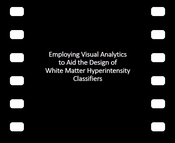Information
- Publication Type: Journal Paper (without talk)
- Workgroup(s)/Project(s):
- Date: 2016
- Journal: Proceedings of International Conference on Medical Image Computing and Computer Assisted Intervention (MICCAI)
Abstract
Accurate segmentation of brain white matter hyperintensi-ties (WMHs) is important for prognosis and disease monitoring. To thisend, classi ers are often trained { usually, using T1 and FLAIR weightedMR images. Incorporating additional features, derived from di usionweighted MRI, could improve classi cation. However, the multitude ofdi usion-derived features requires selecting the most adequate. For this,automated feature selection is commonly employed, which can often besub-optimal. In this work, we propose a di erent approach, introducing asemi-automated pipeline to select interactively features for WMH classi -cation. The advantage of this solution is the integration of the knowledgeand skills of experts in the process. In our pipeline, a Visual Analytics(VA) system is employed, to enable user-driven feature selection. Theresulting features are T1, FLAIR, Mean Di usivity (MD), and RadialDi usivity (RD) { and secondarily,CSand Fractional Anisotropy (FA).The next step in the pipeline is to train a classi er with these features,and compare its results to a similar classi er, used in previous work withautomated feature selection. Finally, VA is employed again, to analyzeand understand the classi er performance and results.Additional Files and Images
Weblinks
No further information available.BibTeX
@article{raidou_miccai16,
title = "Employing Visual Analytics to Aid the Design of White Matter
Hyperintensity Classifiers.",
author = "Renata Raidou and Hugo J. Kuijf and Neda Sepasian and Nicola
Pezzotti and Willem H. Bouvy and Marcel Breeuwer and Anna
Vilanova i Bartroli",
year = "2016",
abstract = "Accurate segmentation of brain white matter
hyperintensi-ties (WMHs) is important for prognosis and
disease monitoring. To thisend, classi
ers are often trained
{ usually, using T1 and FLAIR weightedMR images.
Incorporating additional features, derived from
di
usionweighted MRI, could improve classi
cation. However,
the multitude ofdi
usion-derived features requires selecting
the most adequate. For this,automated feature selection is
commonly employed, which can often besub-optimal. In this
work, we propose a di
erent approach, introducing
asemi-automated pipeline to select interactively features
for WMH classi
-cation. The advantage of this solution is
the integration of the knowledgeand skills of experts in the
process. In our pipeline, a Visual Analytics(VA) system is
employed, to enable user-driven feature selection.
Theresulting features are T1, FLAIR, Mean Di
usivity
(MD), and RadialDi
usivity (RD) { and secondarily,CSand
Fractional Anisotropy (FA).The next step in the pipeline is
to train a classi
er with these features,and compare its
results to a similar classi
er, used in previous work
withautomated feature selection. Finally, VA is employed
again, to analyzeand understand the classi
er performance
and results.",
journal = "Proceedings of International Conference on Medical Image
Computing and Computer Assisted Intervention (MICCAI)",
URL = "https://www.cg.tuwien.ac.at/research/publications/2016/raidou_miccai16/",
}


